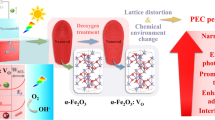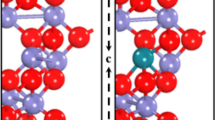Abstract
Hematite α-Fe2O3 is exposed to be an efficient photocatalytic material for the photoelectrochemical water splitting process under visible light. In the present work, we have improved the photocatalytic activity of hematite by varying tin concentration substituted for Fe in pristine hematite. To investigate the influence of the contents of Sn on the photocatalytic activity, various key properties like electronic structure and optoelectronic properties were studied based on density functional theory using generalized gradient approximation plus on-site Hubbard interaction within the WIEN2k computer program. The results of the electronic band structure show the insulating character of the pristine hematite exhibits a bandgap of 2.17 eV equals to Exp. one. The electronic structure calculations of the Sn-doped hematite explore the engineering of the orbitals around the Fermi level and result in a reduction in the bandgap, which is attributed to the corresponding Sn contents. The doping of Sn in Fe2O3 would introduce sub-bands (intermediate band) in between the valence band maximum (VBM) and Fermi level EF, and more interestingly, half-filled intermediate bands appear around the Fermi level with the increase of Sn contents. To see the effect of intermediate bands on the optoelectronic features of the Sn-doped hematite, we also calculated the optical properties of pristine and doped hematite, which predict extra peaks assigned to transitions of electrons from intermediate bands in the infrared region. Our findings explore that the presence of intermediate bands facilitates the PEC activity of water splitting of Fe2O3, shifting from visible light to infrared region. Here, we demonstrate the idea of intermediate bands in hematite for distinctive device applications.









Similar content being viewed by others
References
Walter MG, Warren EL, McKone JR, Boettcher SW, Mi QX, Santori EA, Lewis NS (2010) Solar water splitting cells. Chem Rev 110(11):6446–6473
Tan HL, Abdi FF, Ng YH (2019) Heterogeneous photocatalysts: an overview of classic and modern approaches for optical, electronic, and charge dynamics evaluation. Chem Soc Rev 48(5):1255–1271
Perera F (2018) Pollution from fossil-fuel combustion is the leading environmental threat to global pediatric health and equity: solutions exist. Int J Environ Res Public Health 15(1):16
Zinatloo-Ajabshir S, Morassaei MS, Amiric O, Salavati-Niasari M (2020) Green synthesis of dysprosium stannate nanoparticles using Ficus carica extract as photocatalyst for the degradation of organic pollutants under visible irradiation. Ceram Int 46(5):6095–6107
Zinatloo-Ajabshir S, Ghasemian N, Salavati-Niasari M (2020) Green synthesis of Ln2Zr2O7 (Ln = Nd, Pr) ceramic nanostructures using extract of green tea via a facile route and their efficient application on propane-selective catalytic reduction of NOx process. Ceram Int 46(1):66–73
Zinatloo-Ajabshir S, Morassaei MS, Salavati-Niasari M (2018) Nd2Sn2O7 nanostructures as highly efficient visible light photocatalyst: green synthesis using pomegranate juice and characterization. J Clean Prod 198:11–18
Zinatloo-Ajabshir S, Mortazavi-Derazkola S, Salavati-Niasari M (2017) Sonochemical synthesis, characterization and photodegradation of organic pollutant over Nd2O3 nanostructures prepared via a new simple route. Sep Purif Technol 178:138–146
Zinatloo-Ajabshir S, Mortazavi-Derazkola S, Salavati-Niasari S (2017) Preparation, characterization and photocatalytic degradation of methyl violet pollutant of holmium oxide nanostructures prepared through a facile precipitation method. J Mol Liq 231:306–313
Mortazavi-Derazkola S, Zinatloo-Ajabshir S, Salavati-Niasari M (2017) Facile hydrothermal and novel preparation of nanostructured Ho2O3 for photodegradation of eriochrome black T dye as water pollutant. Adv Powder Technol 28(3):747–754
Zinatloo-Ajabshir S, Salehi Z, Salavati-Niasari M (2018) Green synthesis and characterization of Dy2Ce2O7 nanostructures using Ananas comosus with high visible-light photocatalytic activity of organic contaminants. J Alloys Compd 763:314–321
Ling YC, Wang GM, Wheeler DA, Zhang JZ, Li Y (2011) Sn–doped hematite nanostructures for photoelectrochemical water splitting. Nano Lett 11(5):2119–2125
Iordanova N, Dupuis M, Rosso KM (2005) Charge transport in metal oxides: a theoretical study of hematite α–Fe2O3. J Chem Phys 122(14):144305–144314
Tian CM, Li WW, Lin YM, Yang ZZ, Wang L, Du YG, Xiao HY, Qiao L, Zhang J, Chen L, Qi DC, MacManus-Driscoll JL, Zhang KHL (2020) Electronic structure, optical properties and photoelectrochemical activity of Sn doped Fe2O3 thin films. J Phys Chem C 124(23):12548–12558
Mettenbörger A, Gönüllü Y, Fischer T, Heisig T, Sasinska A, Maccat C, Carraro G, Sada C, Barreca D, Mayrhofer L, Moseler M, Held A, Mathur S (2016) Nano Energy 19:415–427
Castelli IE, Olsen T, Datta S, Landis DD, Dahl S, Thygesen KS, Jacobsen KW (2011) Computational screening of perovskite metal oxides for optimal solar light capture. Nano Lett 11:1775–1781
Meng XY, Qin GW, Li S, Wen XH, Ren YP, Pei WL, Zuo L (2011) Enhanced photoelectrochemical activity for Cu and Ti doped hematite: the first principles calculations. Appl Phys Lett 98(11):112104–112106
Hufnagel AG, Hajiyani H, Zhang S, Li T, Kasian O, Gault B, Breitbach B, Bein TF, Rohlfing D, Schue C, Pentcheva R (2018) Why tin-doping enhances the efficiency of hematite photoanodes for water splitting–the full picture. Adv Funct Mater 14:1804472–1804482
Cesar I, Kay A, Martinez JAG, Gratzel M (2006) Translucent thin film Fe2O3 photoanodes for efficient water splitting by sunlight: nanostructure-directing effect of Si-doping. J Am. Chem. Soc 128:4582–4583
Zhang S, Hajiyani H, Hufnagel AG, Kampmann J, Breitbach B, Bein T, Fattakhova-Rohlfing D, Pentcheva R, Scheu C (2020) Sn-doped hematite for photoelectrochemical water splitting: the effect of Sn concentration Z. Phys Chem 234(4):683–698
Aguilera I, Palacios P, Wahnon P (2011) Understanding Ti intermediate-band formation in partially inverse thiospinel MgIn2S4 through many-body approaches. Phys Rev B 84:115101–115106
Luque A, Martı A (1997) Increasing the efficiency of ideal solar cells by photon induced transitions at intermediate levels. Phys Rev Lett 78(26):5014–5017
Franco FD, Zaffora A, Santamaria M (2018) Bandgap narrowing and dielectric constant enhancement of (NbxTa(1-x))2O5 by electrochemical nitrogen doping. Electrochim Acta 265:326–335
Blah P, Schwarz K, Madsen G, Kvasnicka D, Luitz J (2001) WIEN2k, an augmented plane wave plus local orbitals program for calculating crystal properties. Austria, Karlheinz Schwarz, Techn Universitt Wien
Osterloh FE (1927) The calculation of atomic fields. Proc Camb Philos Soc 23:542–548
Fermi E (1928) Eine statistische Methode zur Bestimmung einiger Eigenschaften des Atoms und ihre Anwendung auf die Theorie des periodischen Systems der Elemente. Acta Chem Scand 48:73–79
Hohenberg P, Kohn W (1964) Nobel Lecture, Inhomogeneous electron gas. Rev. Mod. Phys 136:864–871
Perdew JP, Burke K, Ernzerhof M (1996) Generalized gradient approximation made simple. Phys Rev Lett 77(18):3865–3868
Li AI, Anisimov VI, Zaanen J (1995) Density-functional theory and strong interactions: orbital ordering in Mott-Hubbard insulators. Phys Rev B 52:R5467
Monkhorst HJ, Pack JD (1976) Special points for Brillouin-zone integrations. Phys Rev B 16:5188–5192
Sandratskii LM, Uhl M, Kubler J (1996) Band theory for electronic and magnetic properties of α–Fe2O3. J Phys Condens Matter 8(8):983–989
Zhou Z, Huo P, Guo L, Prezhdo OV (2015) Understanding hematite doping with group IV elements: a DFT+U study. J Phys. Chem C 119:26303–26310
Ceperley DM, Alder BJ (1980) Ground state of the electron gas by a stochastic method. Phys Rev B 45:566
Rollmann M, Rohrbach A, Entel P, Hafne J (2004) First–principles calculation of the structure and magnetic phases of hematite. J Appl Phys 69:165107–165119
Punkkinen MPJ, Kokko K, Hergert W, Vayrynen IJ (1999) Fe2O3 within the LSDA + U approach. J Phys Condens Matter 111:2341–2349
Liao PL, Carter EA (2011) Testing variations of the GW approximation on strongly correlated transition metal oxides: hematite (α–Fe2O3) as a benchmark. Phys Chem Chem Phys 13(33):15189–15199
Liao PL, Carter EA (2012) Understanding intermediate-band solar cells. Nat Photon 6:146–152
Lopez N, Reichertz LA, Yu KM, Campman K, Walukiewicz W (2011) Engineering the electronic band structure for multiband solar cells. Phys Rev Lett 106(2):028701–028704
Droubay T, Rosso KM, Heald SM, McCready DE, Wang CM, Chambers SA (2007) Structure, magnetism, and conductivity in epitaxial Ti-doped Fe2O3 hematite: experiment and density functional theory calculations. Phys. Rev. B 75(10):104412
Yang C, Qin M, Wang Y, Wan D, Huang F, Lin J (2013) Observation of an intermediate band in Sn–doped chalcopyrites with wide-spectrum solar response. Phys Rev Lett 3:1286–1292
Rani BJ, Ravi G, Yuvakkumar R, Ravichandran S, Ameen F, AlNadhary S (2019) Sn doped α-Fe2O3 (Sn=0,10,20,30 wt%) photoanodes for photoelectrochemical water splitting applications. Renewable Energy 133:566–574
Orlandi M, Mazzi A, Arbana G, Bazzanella N, Rudatisb P, Caramori S, Patel N, Fernandes R, Bignozzi CA, Miotello A (2016) On the effect of Sn-doping in hematite anodes for oxygen evolution. Electrochim Acta 214:345–353
Sharma V, Wang C, Lorenzini RG, Ma R, Zhu Q, Sinkovits DW, Pilania G, Oganov AR, Kumar S, Sotzing GA, Boggs SA, Ramprasad R (2014) Rational design of all organic polymer dielectrics. Nat Commun 5(1):4845–4852
Ghiringhelli LM, Vybiral J, LeVchenko SV, Draxl C, Scheffler M (2015) Big data of materials science: critical role of the descriptor. Phys Rev Lett 114(10):105503–105507
Kondofersky I, Dunn HK, Mller A, Mandlmeier B, Feckl JM, Fattakhova-Rohlfingn D, Scheu C, Peter LM, Bein T (2015) Electron collection in HostGuest nanostructured hematite photoanodes for water splitting: the influence of scaffold doping density. Appl Mater Interfaces 7(8):4623–4630
Wasserman AL (2005) Effective masses. Encyclopedia of Condensed Matter Physics. 1–5. doi:https://doi.org/10.1016/b0-12-369401-9/00457-5
Funding
W. Khan and S. A. Khan were supported by the CEDAMNF project (CZ.02.1.01/0.0/0.0/15_003/0000358). W. Khan was also supported by the Higher Education Commission: No 21: 2484/SRGP/R&D/HEC/2019.
Author information
Authors and Affiliations
Corresponding author
Additional information
Publisher’s note
Springer Nature remains neutral with regard to jurisdictional claims in published maps and institutional affiliations.
Rights and permissions
About this article
Cite this article
Khan, W., Minar, J., Khan, S.A. et al. Theoretical analysis of an intermediate band in Sn-doped hematite with wide-spectrum solar response. J Solid State Electrochem 25, 731–742 (2021). https://doi.org/10.1007/s10008-020-04849-y
Received:
Revised:
Accepted:
Published:
Issue Date:
DOI: https://doi.org/10.1007/s10008-020-04849-y




